This article needs additional citations for verification .(December 2023) |

The Teatro Petruzzelli is the largest theatre of the city of Bari and the fourth Italian theatre by size.
This article needs additional citations for verification .(December 2023) |

The Teatro Petruzzelli is the largest theatre of the city of Bari and the fourth Italian theatre by size.
The history of the Teatro Petruzzelli of Bari begins when Onofrio and Antonio Petruzzelli, traders and ship builders from Bari, [1] presented the designs for the theatre drawn up by their brother-in-law, the engineer Angelo Bari Cicciomessere (then Messeni) to the city of Bari. The proposal for building the Petruzzelli was accepted and, on 29 January 1896, a contract was signed between the family and the city administration. Two years later, in October 1898, work began and it ended in 1903.
The interior of the theatre was painted by Raffaele Armenise. On completion the Teatro Petruzzelli overtook the Teatro Comunale of Corato as the largest theatre of Apulia. The theatre was inaugurated on Saturday, 14 February 1903 with Meyerbeer's Les Huguenots .
In the 1980s, the theatre hosted two major operatic debuts, that of Iphigénie en Tauride by Niccolò Piccinni which had never been presented after its debut in Paris in 1779, and the Neapolitan version of Bellini's I Puritani , which was written for Maria Malibran but was never performed by her. Both events contributed to making the city world-famous.
In addition to operas, ballets and big concerts were presented. Many great international artists have performed at the Petruzzelli: these include Tito Schipa, Herbert von Karajan, Rudolf Nureyev, Frank Sinatra, Ray Charles, Liza Minnelli, Juliette Gréco. Great Italian artists include Eduardo De Filippo, Riccardo Muti, Carla Fracci, Luciano Pavarotti, Piero Cappuccilli and Giorgio Gaber.
The Petruzzelli also hosted important concerts of light music (among others concerts by Paolo Conte and Ornella Vanoni) and it was the headquarters of Azzurro, a musical programme, for almost all of the 1980s. The interior was also used as a location for films such as Il giovane Toscanini by Franco Zeffirelli and Polvere di stelle by Alberto Sordi.
During the night of 26 and 27 October 1991 the theatre was completely destroyed by fire, the result of arson. The last opera presented was Norma .

The criminal trial of those accused of setting the fire ended with the acquittal of the defendants and the condemnation of the perpetrators of the incident.
A civil action followed which involved the Messeni Nemagna family and temporary manager Fernando Pinto, who was accused of failing to insure the theatre, ended with his conviction and the order to pay compensation of 57 billion lire in favour of the owners of the theatre. On 21 November 2002 the Ministry for Heritage and Cultural Activities signed a "Protocol of Understanding" between the family that owned the theatre and the City, the Province of Bari and the Apulia Region, stating that the theatre would be rebuilt by 22 November 2006.
However, since the work of reconstruction never started, on 3 October 2006 the Theatre become the property of the Municipality of Bari in accordance with an Article related to the Finance Act of 2006. But on 30 April 2008 the Constitutional Court, in its decision No. 128/2008 [2] ordered that the Theatre be given back to the Messeni Nemagna family.
The Petruzzelli, reconstructed entirely with public money in 2008, was returned to the City of Bari on 7 September 2009 for breach of article 5 of the contract dated 29 January 1896 between the City of Bari and Antonio Onofrio and Petruzzelli. The article stated: "In the event that the building collapses because of an earthquake, fire or for any other cause, the grantee and its successors would have the right to rebuild the Politeama to its original state, provided that the work was undertaken within a year and be completed in three years from the date on which the collapse has occurred, or have a duty to clear the land and leave it free of debris and return it to the City within a year counting from the above term."
The Fondazione Lirico Sinfonica Petruzzelli e Teatri di Bari was eventually identified as the only entity able to assume the management, maintenance and insurance of the Teatro Petruzzelli, based on what was written in former Article 23 of Law 800, which states that municipalities must make theatres available for opera companies after the end of concert seasons. The Teatro Petruzzelli officially reopened Sunday 4 October 2009, nearly 18 years after the fire, with a performance of the Ninth Symphony by Ludwig van Beethoven by the Orchestra of the Province of Bari, conducted by Fabio Mastrangelo.
On 6 December 2009 the first opera season in the re-built theatre began with Turandot by Giacomo Puccini, directed by Roberto De Simone, with the orchestra conducted by Renato Palumbo.

The Teatro Colón is a historic opera house in Buenos Aires, Argentina. It is considered one of the ten best opera houses in the world by National Geographic. According to a survey carried out by the acoustics expert Leo Beranek among leading international opera and orchestra directors, the Teatro Colón has the room with the best acoustics for opera and the second best for concerts in the world.

Niccolò Piccinni was an Italian composer of symphonies, sacred music, chamber music, and opera. Although he is somewhat obscure today, Piccinni was one of the most popular composers of opera—particularly the Neapolitan opera buffa—of the Classical period.

The Real Teatro di San Carlo, as originally named by the Bourbon monarchy but today known simply as the Teatro (di) San Carlo, is a historic opera house in Naples, Italy, connected to the Royal Palace and adjacent to the Piazza del Plebiscito. It is the oldest continuously active venue for opera in the world, having opened in 1737, decades before either Milan's La Scala or Venice's La Fenice.

The Teatro Comunale di Bologna is an opera house in Bologna, Italy. Typically, it presents eight operas with six performances during its November to April season.

The Teatro Argentina is an opera house and theatre located in Largo di Torre Argentina, a square in Rome, Italy. One of the oldest theatres in Rome, it was constructed in 1731 and inaugurated on 31 January 1732 with Berenice by Domenico Sarro. It is built over part of the curia section of the Theatre of Pompey. This curia was the location of the assassination of Julius Caesar.
The Music of Apulia has had some glorious history as well as some very hard times. Located along the southern Adriatic, the area was part of Magna Grecia and certainly one of the centers of Ancient Greek music. And 1,000 years ago, Bari, on the coast, was a privileged sanctuary for pilgrims and Crusaders on their way to the Holy Land. Yet, the only musical relic that remains from the period is the Excultet, a representation from the 11th century of two angels playing trumpets that is preserved in the Basilica of San Nicola in Bari. Later, as part of the Kingdom of Naples, Apulia produced many memorable names in music, but like elsewhere in the south, many of them gravitated to Naples, the capital of the kingdom.

The Teatro San Cassiano was the world's first public opera house, inaugurated as such in 1637 in Venice. The first mention of its construction dates back to 1581. The name with which it is best known comes from the parish in which it was located, San Cassiano, in the Santa Croce district (‘sestiere’) not far from the Rialto.
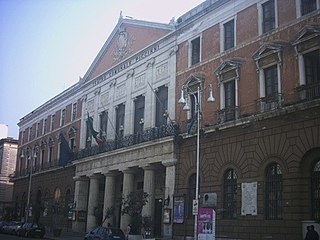
Teatro Piccinni is a theatre in the city of Bari, Apulia on the east coast of Italy. It was founded in 1854 and opened on 30 May of that year. It was named in honor of eighteenth-century composer Niccolò Piccinni who was born in Bari.

Iphigénie en Tauride is a tragédie lyrique in four acts by Niccolò Piccinni, which was first performed on 23 January 1781 by the Académie royale de musique in the second Salle du Palais-Royal. The opera's libretto, by Alphonse du Congé Dubreuil, is based on a play of the same name by Claude Guimond de La Touche, although the ultimate source was the tragedy Iphigeneia in Tauris by Euripides.
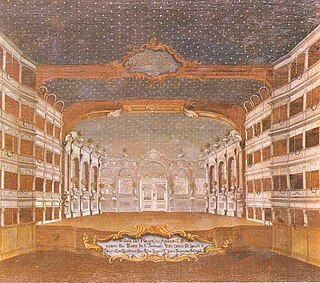
Teatro San Samuele was an opera house and theatre located at the Rio del Duca, between Campo San Samuele and Campo Santo Stefano, in Venice. One of several important theatres built in that city by the Grimani family, the theatre opened in 1656 and operated continuously until a fire destroyed the theatre in 1747. A new structure was built and opened in 1748, but financial difficulties forced the theatre to close and be sold in 1770. The theatre remained active until 1807 when it was shut down by Napoleonic decree. It reopened in 1815 and was later acquired by impresario Giuseppe Camploy in 1819. In 1853 the theatre was renamed the Teatro Camploy. Upon Camploy's death in 1889, the theatre was bequeathed to the City of Verona. The Venice City Council in turn bought the theatre and demolished it in 1894.
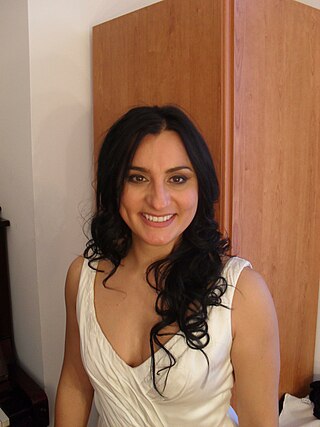
Carmela Remigio is an Italian operatic soprano.

The Teatro delle Dame, also known as the Teatro Alibert, was a theatre in Rome built in 1718 and located on what is now the corner of Via D'Alibert and Via Margutta. In the course of its history it underwent a series of reconstructions and renovations until it was definitively destroyed by a fire in 1863. In their 18th-century heyday, the Teatro delle Dame and its rival, the Teatro Capranica, were the leading opera houses in Rome and saw many world premieres performed by some of the most prominent singers of the time.
Fabio Ceresa is an Italian opera director and librettist.
The following is a timeline of the history of the city of Bari in the Apulia region of Italy.

The Teatro Nuovo is a theatre located on Via Montecalvario in the Quartieri Spagnoli district of Naples. The original theatre was an opera house designed by Domenico Antonio Vaccaro. Completed in 1724, it was also known as the Teatro Nuovo sopra Toledo and the Teatro Nuovo de Montecalvario. The theatre specialised in the opera buffa genre and saw the world premieres of hundreds of operas in its heyday. These included fifteen of Cimarosa's operas and seven of Donizetti's. The present theatre is the third to have been erected on the site following its destruction by fire in 1861 and again in 1935.
Alvise Casellati is an Italian conductor.
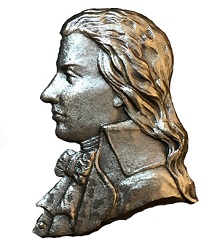
Luigi Capotorti was an Italian composer of both sacred and secular music. He was the maestro di cappella of several Neapolitan churches; the composer of ten operas, five of which premiered at the Teatro San Carlo in Naples; and a teacher of composition and singing whose students included Stefano Pavesi and Saverio Mercadante. Born in Molfetta, he studied violin and composition at the Conservatorio di Sant'Onofrio in Naples and spent his entire career in that city. In his later years, Capotorti retired to San Severo, where he died at the age of 75.
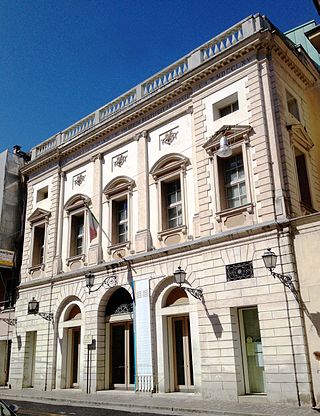
The Teatro Mario Del Monaco is an opera house and theatre in Treviso, Italy. It was previously known as the Teatro Onigo from 1692 to 1846, the Teatro Sociale from 1847 to 1930, and the Teatro Comunale from 1931 to 2011. In 2011, it was renamed in honour of the Italian tenor Mario Del Monaco who lived in Treviso from 1975 until his death in 1982. It is located in the historic centre of the city on the Corso del Popolo and since 2019 has been run by the Teatro Stabile del Veneto which also runs the Teatro Goldoni in Venice and the Teatro Verdi in Padua.
Gianluca Martinenghi is an Italian opera and symphonic music conductor. From 2016 to 2018 he was the Music director of Macedonian National Theatre. Currently he is the Artistic Secretary of Teatro Reggio in Turin, Italy,

The culture of Apulia, the region that constitutes the extreme southeast of the Italian peninsula, has had, since ancient times, mixed influences from the West and the East, due to its strategic position near the transition zone between these two cultural regions. Its location, on the west coast of the Adriatic and Ionian seas, the natural southern border between Western Europe and the Balkans and Greece, made it a bridge to the East since antiquity, and in the Middle Ages, it was a cultural frontier between the Roman-Germanic West and the Greek-Byzantine East.
Notes